
A Guide to the Amphibians
and Reptiles of California

Frog Deformities and Malformations

| Deformed Frogs in California | 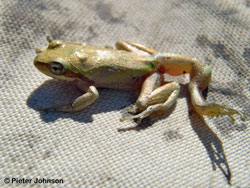 © Pieter Johnson 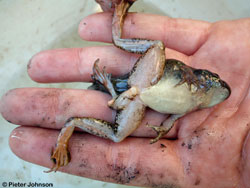 © Pieter Johnson  © Pieter Johnson 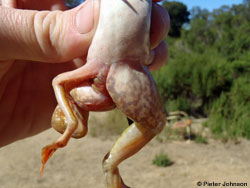 © Pieter Johnson |
Pieter Johnson, Ph.D., Department of Ecology and Evolutionary Biology, University of Colorado, Boulder, CO 80309 pieter.johnson@colorado.edu The Johnson Lab Web Site |
|
| Background | |
| Severe deformities and malformations have been reported in amphibian populations with growing frequency since the early 1990s. Typically such abnormalities involve the limbs and especially the hind limbs of affected frogs, including deformities such as extra limbs or digits, missing limbs or portions of limbs, or limbs that are twisted and misshapen. These abnormalities are most common in frogs that have recently metamorphosed from their tadpole stage, likely because affected individuals do not survive to adulthood. Malformed individuals do not swim, jump or forage as well as their normal counterparts and field studies have shown they have reduced survival in natural populations. While the baseline or “normal” level of abnormalities in frog population ranges from around 1 to 3%, recent reports have included accounts of populations with >20% malformations all the way up to 100%. High frequencies of malfomations have the potentially to negatively impact frog populations and their long-term persistence. |
|
| Possible Causes | |
| Many factors have the potential to cause deformities in frogs, including chemical pollution (e.g., pesticides), heavy metals (e.g., mercury), non-native predators (e.g., fish and crayfish), and parasitic infections. In California and the western United States, infection by a parasite appears to be especially important in explaining accounts of limb deformities in frogs. This parasite (Ribeiroia ondatrae) is flatworm trematode or fluke – which is a type of worm – that uses freshwater snails, amphibians, as well as birds to complete its life cycle. The parasites burrow into the developing limb tissue of tadpoles, leading to a disruption of normal growth that results in extra limbs, abnormal limbs, missing limbs or even death of the frog. It is believed that these malformations help the parasite by making frogs more vulnerable to predation by birds, which is the final host of the parasite and helps it to move across the landscape. |
|
| What is Being Done to Study This issue? | |
| Researchers at the University of Colorado are working actively to understand the distribution of frog malformations, their consequences for amphibian population persistence, and what other factors may control their abundance. The key question being investigated is ‘why do these malformations seem to be on the rise?’ To understand the answer to this question, the researchers are examining how environmental changes affect how many parasites there are, including the influence of nutrient pollution, climate change, and biodiversity loss. |
|
| More Information | |
| For more images and information about amphibian malformations please visit the Johnson Lab site, https://www.colorado.edu/lab/johnson-laboratory/research/amphibian-deformities-and-disease or download a .pdf brochure about amphibian conservation and frog deformities. |
|
| You Can Help - Report Your Observations of Deformed Frogs | |
If you see frogs with deformities or malformations, photograph them and record the location where you observed them. This information is extremely useful to researchers. You can send along an email account to: pieter.johnson@colorado.edu. |
|
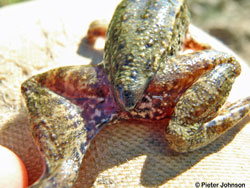 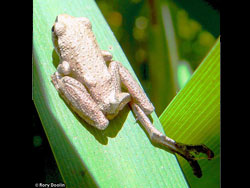 © Pieter Johnson © Rory Doolin |
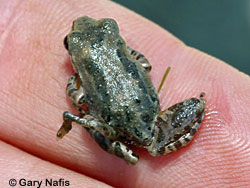 © Gary Nafis |
Return to the Top
© 2000 -